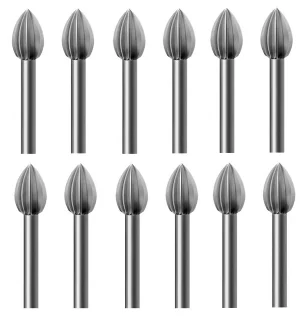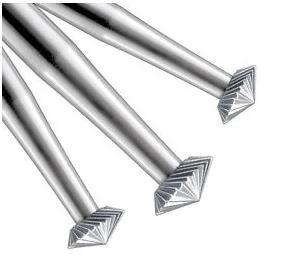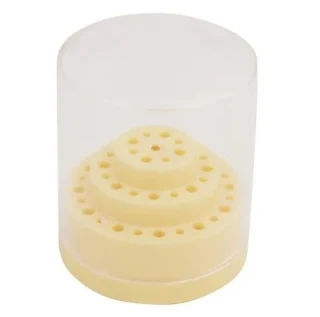I've written about our 'burs' in my previous essays, but it's good to repeat this topic again. Burs come in all sizes, shapes and steel strengths.
Their sizes start at .03mm's and go up to 10.00mm's, I know this for a fact as many of my (HSS) "High Speed Steel" burs are in this range.
Carbide steel burs are meant solely for making "4-claw" bearings, then they are of the 'HSS' composition.
===========================================
These strange looking burs have just one purpose and that is to create a seat for 'half-round pearls'. The little extruding tip is solely for making sure where the centre of the pearl will be sitting, it also keeps the drilling bur well-centered.
If the 'triangular tip' wasn't there, the rotating bur would 'run at full speed' all over the surface of the metal. The speed of rotation should be SLOW (allowing the slanted tooth of the bur to cut gently into the metal).
Many jewellers (even setters) use this straight-edged bur to create seats for stone setting. The yellow band lets you know that this bur is of "High Speed Steel".
This wonderful bur is also named "156C" the letter "C" means that it is made of Carbide steel. BTW, I use this bur on many occasions in making detailed cuts in the metal for stone setting. They come in many sizes starting at 0.003 mm's up to 0.28mm's or more.
This is my 'buddy-bur", these burs are used from opening up the setting hole where the Pavilion of the stone will sit.
I always have a wide selection of these burs just in case one gets worn down, I have another to be replace. Fixing the teeth is highly frowned upon as the costs for constant maintenance is not worth the time or effort.
I have at least 6 to 8 of these 'bur pads' near my bench-tray. Each design will have its own pad. Are these good to have? I think so.
This bur pad would be used for jewellers and they can place their pliers in the center opening receptacle.
This (rotating) bur pad can easily hold any size of width of bur. This is great when searching for that one hard to locate bur.
This 'odd looking' bur has just one purpose and that is to make the tips of the claws round. There is little need to shape any claw round with your Triangular file.
As you can see that the teeth of the cutting is inside of the hollow opening. The refers to the name of this bur which is "77B", the letter B refers to "Ball".
This 'twisted looking steel bur' is for making holes and they are intended just for this purpose. They will 'gently' drill holes into the metal, prior to any round hole drilling for stone setting.
The yellow band denotes that this bur is of "HSS" or "High-Speed Steel". It does not mean that you should run the bur fast as possible, but it means that the steel is of a higher quality of metal.
These burs are used in making 'seats' prior to gem stone setting. You can now see the teeth being more deep, not like the Carbide burs. The dimensions of these teeth measure at the same angle as a diamond.
Here are the Carbide burs, you can see how close the teeth are as compared with the HSS burs.
You can see the yellow band (again) on this Round bur. This is done on purpose as the setter will easily know that this is a 'HSS' bur and not a regular 'Carbide' softer steel bur.
Round burs start in size from 0.003 mm's and all the way up to 10.0 mm's.
This little plastic 'bur-holder' is mainly used as an extra method of keeping your burs from the other tools on your bench-top.
Many times I will insert tissue paper laden with a lubricant to keep the bur moist and avoid any rust.
Here are a few of the many sizes of the "77B" Cup burs. I always have a large assortment if I need one at a moments notice. Many times if one bur is too small, or too large, I have others to 'pick and choose'.

I hardly ever use the "70 degree" (not shown) why is this? I've never had the opportunity of setting a stone with those dimensions.
This HSS bur is used in primarily preparing seats inside of a "4-claw" head. I use many sizes from 1.0 mm's up to 5.0mm's, as these could be used in cluster type rings.
This photo is of a HSS '156' shaped bur, you can see the spacing of all of the teeth. This will denote the 'aggressive' nature of the cutting of the seats in the metal.
Here are a full range of "Twist-Drill" burs. These burs are so very to sharpen again if the tips of the bur get worn down. I will use a 'Separating Disk' to do reclaim the cutting edge.
This is the second photo showing the range of Round burs. It's imperative to keep a wide assortment of burs of both size and design within easy reach at your 'working bench'. I always have numerous boxes like these within easy 'arms reach'. If the need of a particular bur, there it is waiting for me. I will gladly pay the extra few dollars to keep these burs ready for instant use.

.jpg)















.jpg)
.jpg)





No comments:
Post a Comment